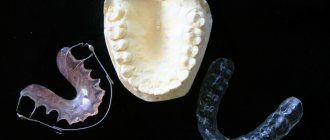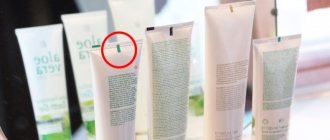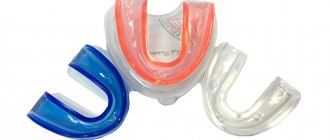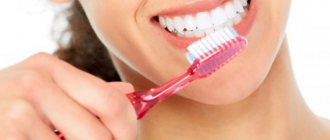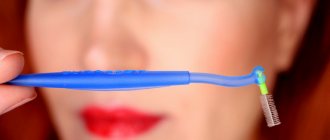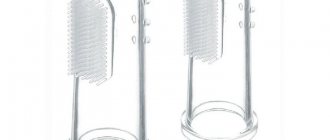On the Internet you can find many videos on how to properly tighten the plate for the upper and lower teeth using a key that is specially designed for this. Parents have a lot of questions about how to perform all the manipulations effectively and without harming the child.
After installing the structure, the orthodontist will show you how to tighten the mechanism and develop an individual schedule that should be followed throughout the entire therapeutic course, with possible deviations depending on the clinical picture and dynamics. If adults are vigilant and strictly control the entire treatment process, a positive result will not be long in coming, and after 1.5-2 years the little patient will be able to boast of straight teeth.
What it is
Typically, in children aged 6-14 years, removable appliances are used to correct malocclusion. The most effective is the plate. It is involved in the process of jaw growth and puts pressure on the teeth, which subsequently move in the desired direction.
It should only be prescribed by a doctor if indicated. As a rule, this occurs during the period of active growth and change in the primary occlusion until the jaw bones are finally formed. This happens around 12-14 years of age. In some cases, it is recommended to resort to correction at primary school age.
The device is worn for an average of 1.5 to 2 years. It is necessary to perform periodic pulling and twisting, the frequency of which depends on the degree of curvature, the presence of crowding and other pathological changes in the child’s dental system.
Using the plate helps:
- alignment of dentition, elimination of crowding;
- adjusting the shape of the jaw;
- increasing or decreasing the size of the sky, etc.
Many parents begin to worry when the orthodontist informs them about the need to periodically tighten the arches, and with fear they watch a video on how to tighten (twist) the upper or lower plate for the teeth. This is the most important stage of treatment, since the effectiveness of the entire therapeutic process depends on it. By understanding the nuances of the procedure, you can provide your child with a dazzling smile in adolescence and adulthood.
Prices
The cost of straightening plates depends on the design features, selected materials and the level of the clinic. On average, the price of an ordinary plate of a standard color, made of medium-hard plastic without additional elements, is no more than 10,000 rubles.
Models with the same characteristics, but made using colored material or plastic of increased softness, will cost from 12,000 rubles or more.
Complex type devices, supplemented with one screw, have an average cost of 9,000 rubles. Installing each additional screw will cost 1000–2000 rubles, and equipping the orthodontic system with a special tongue flap will cost 500–1500 rubles.
The average cost of a device for straightening premolars and molars is 14,000 rubles.
Prices for installation services vary depending on the dental clinic, materials and features of the device being installed.
The average price of procedures usually includes the cost of the device and material. After installation, you will have to pay for further visits to the dentist while wearing it.
The cost of procedures may vary depending on the list of services provided and amount to up to 80,000 rubles. Exact prices must be obtained from the clinic.
| Clinic name | Service | Cost, rub.) |
| Clinic of Doctor Dubkov | Expansion plates Installing a permanent plate | 7000 3000 |
| Orthodontist-Complex | Vestibular plate | 10500 |
| Smile laboratory | Retention plate | 6585 |
| Alpha Clinic | Device with one screw, with two screws | 7500 8500 |
| Beauty Smile Clinic | Plate with screw for one jaw | 8000 |
Types of designs and their features
Various types of plates are used to correct malocclusion and eliminate other aesthetic and functional defects. Depending on their purpose, they can be removable or non-removable. There is also a classification by location: on the lower or upper jaw. There are monoblock, double-jaw devices.
Wearing devices that can be easily removed from the dentition if necessary is much easier for young patients to tolerate. This is due to the fact that if discomfort occurs, you can remove the arches from the mouth for a while and slightly delay the next tightening of the screw. However, it is important to remember that unpleasant sensations (difficulties with diction, minor pain) disappear after a few days. It’s better not to take anything out again. This is done only before tightening the teeth plate. If you allow your child to remove it too often, the treatment will not have any effect.
The orthodontist decides which mechanism is best suited in a particular case. Children are more often fitted with a Brückl or Frenkel apparatus. Constructions that are not removed until the end of the therapeutic course should only be adjusted by a doctor.
Fixed
The Ross plate is the most popular for correcting defects in patients aged 6 to 10 years. It is used to correct the upper dentition. Older children are often given braces, which are fixed in the presence of a permanent bite. The system includes plates with holes and locks, which are attached to the teeth using special dental glue and connected to each other by metal arches.
However, calling such structures plates is not entirely correct, since this is an independent type of orthodontic device.
Removable
For babies who still have baby teeth, devices are recommended that can be removed, which means they facilitate daily hygiene and can be taken out when eating and at any other time when it is required. Most often, orthodontists recommend the following types of structures:
- No active elements. Indicated when bite pathologies are minor. For example, if one canine or front incisor deviates.
- Substitutes. In most cases, it is used as a preventive measure to prevent pathologies if some temporary units fell out or were removed much earlier than expected. There are also non-removable versions. Sometimes the system includes artificial crowns, which temporarily replace the lost ones and imitate their presence in the oral cavity.
- Bruckle's apparatus. It is installed on the lower jaw, but also participates in the correction of the upper jaw.
- With active screw. Placed on both rows, they are the most common method of correcting curvature during the change from primary to permanent bite. It is in this case that regular twisting is required. The device is adjusted by parents according to a strictly established schedule, but under the constant supervision of an orthodontist. Let's look at how to tighten a dental plate with a dental key below.
Swiss Center for Aesthetic Medicine MedexCom
Only a doctor can determine the time of wearing this design. He looks at the effectiveness of its use.
If the mechanism is worn correctly and tightened, the average wearing time is about 2 years. This is the period for removable plates, provided that they are on the teeth for at least 21 hours a day.
The clinic is one of the 5 best dentists in Moscow. American technologies and techniques are used in the work. Equipped with equipment from Germany, Japan, Israel, USA. Doctors are members of the American Dental Association.
But the benefits don't end there. The clinic offers patients:
- free initial appointment, consultation and treatment plan;
- payment in installments for a year: first installment 4,000 rubles. monthly;
- combined systems - aesthetic braces are installed on the teeth in the smile area, cheaper metal braces are installed on the chewing teeth;
- full service for a year without additional payments.
American Dental is one of the 5 best dentists in Moscow.
| View | Amount in rubles |
| Metal | 57,500, initial payment – 9,500 |
| Self-ligating | 62,500, initial payment – 14,500 |
| Sapphire | 67,500, first payment – 19,500 |
| Diamond | 85,000, entry fee – 37,000 |
The chief physician personally supervises each patient. He conducts an examination, draws up an optimal treatment plan and monitors every stage. Attention is paid not only to teeth alignment, but also to facial aesthetics.
How much dental braces cost is announced after diagnosis. The price includes all necessary manipulations. There are no hidden fees.
| View | Amount in rubles for both jaws |
| Victory | 131 000 |
| Reflection | 114 000 |
| Damon 3 MX | 178 000 |
| Damon Q | 188 000 |
| Damon 3 | 192 000 |
| Damon Clear | 205 000 |
| Insignia | 238 000 |
| Clarity Advanced | 194 000 |
| Inspire Ice | 198 000 |
| Incognito | 396 000 |
| WIN | 366 000 |
Another specialized orthodontic center in Moscow. Features of dentistry:
- free consultations;
- an individual system of exercises and care is developed for each patient;
- interest-free installments for 12 months, monthly payment – 7,000 rubles;
- transparency of the cost of treatment - the price is announced after drawing up the plan.
The orthodontist gives installments for 12 months.
| View | Amount in rubles for both jaws |
| Ceramic self-ligating (Clarity Advanced, Clarity SL, Smartclip) | 120,000, first installment – 36,000 |
| Metal self-ligating | 110,000, initial payment – 26,000 |
| Combined ceramic Clarity Advanced | 99,900, starting payment – 15,900 |
| Incognito | 450 000 |
| Vestibular external | 99 900 |
All dentists working in the clinic, employees and teachers of research and medical educational institutes. Dentistoff has a powerful orthodontic department that takes on the most complex cases.
| View | Amount in rubles for both jaws |
| Metal | 93 900 |
| Ceramic | 103 900 |
| Sapphire | 143 900 |
| Lingual | 500 000 |
The consultation is free. It includes x-rays and their calculation, taking impressions, drawing up a virtual model of the jaws and a treatment plan.
According to StartSmile, the Dental Guru Center is one of the 20 best dental clinics in Russia. In addition to braces, specialists install removable orthodontic devices (plates, aligners) on the teeth and perform maxillofacial surgeries in difficult cases.
The Dental Guru network of dental clinics installs metal and ceramic braces.
There are two types of braces you can install: metal and ceramic. The price for the first starts from 110,000, for the second - from 150,000 rubles for both jaws.
One of the leading areas of the “Your Dentistry” clinic is orthodontics. The center corrects malocclusions in patients of any age. Features of the clinic:
- deferred payment without interest;
- family discounts and promotions;
- a warranty agreement is concluded for all types of services;
- free examination and treatment plan.
| View | Amount in rubles for one jaw |
| Ligature Smart Chik | 30 000 |
| Self-ligating metal Smart Clip SL | 40 000 |
| Self-ligating metal Damon Q | 55 000 |
| Self-ligating ceramic Damon Clear | 65 000 |
Dentistry is a member of the Association of Leading Clinics of Switzerland and the European Organization for Quality. The clinic has a powerful orthodontic department.
Features of the center:
- To identify pathologies, specialists use X-ray examination and teleradiography;
- the center’s doctors carry out preventive measures in kindergartens and schools;
- patients with congenital pathologies of the maxillofacial apparatus are registered and undergo an annual examination once a year;
- For each patient, an individual myotherapy system is developed - a set of exercises to normalize the functioning of the facial muscles.
| View | Amount in rubles for one jaw |
| Traditional | 18 000 |
| Combined sapphire | 20 000 |
| Sapphire | 26 000 |
| Aesthetic Damon | 33 000 |
The center's doctors carry out preventive measures in kindergartens and schools.
Additional Information! The price is indicated directly for the designs. Consultation, diagnostics, taking impressions, and doctor’s services are paid separately.
In the orthodontic department of the Ilatan dentistry, they correct the dentition of children and adults. The emphasis is on early alignment of primary occlusion and prevention of pathologies. In addition to braces, doctors use many other orthodontic structures: aligners, plates, elastopositioners.
| View | Amount in rubles for one jaw |
| Sapphire | 32 000 |
| Ceramic | 28 000 |
| Metal | 23 000 |
| Aesthetic | from 41,950 to 47,500 |
The cost of the braces itself is indicated. The final price consists of the cost of the structure itself, its installation, activation, removal, preventive maintenance, and the use of additional devices - retainers, aligners.
Device
Before you start adjusting the lock yourself, you need to figure out what the correction device consists of. Standard structure:
- Plastic base that follows the anatomy of the palate and jaws. Solid, durable, but not causing severe discomfort to the child. It comes in different shades, often bright, to appeal to children.
- Wire hooks, which in most cases are attached to the molars.
- Metal arc. It puts pressure on the rows and helps move them in the right direction.
- A screw with a hole located in the center. It is this that is activated and periodically tightened.
- Bright marking arrow indicating the direction for adjusting the device.
Dentistry "Dental World"
Dental World has one of the best and inexpensive orthodontic departments in Moscow. The cost of treatment can be reduced through promotions and discounts on braces up to 40% and free consultations.
In addition to braces, aligners and trainers can be installed in dentistry. Orthodontic mini-implants are also used.
| View | Amount in rubles for one jaw |
| Metal | 25 000 |
| Ceramic | 35 000 |
| Sapphire | 38 000 |
| Lingual non-ligature | 82 000 |
| Self-ligating ceramic | 40 000 |
| Incognito | 98 000 |
| IN-OVATION L | 58 500 |
What does an orthodontic screw in plates look like and what is it for?
This element is also called a lock. It is installed on many corrective structures and is made mainly of stainless steel. There are many types of such mechanisms. Some of them are installed only on the upper jaw, others can work in several directions at once (displace individual dental units, expand rows, etc.).
Screws are a combination of several threaded pins with a thickening in the center, which is called a drum. There are holes in it, it is through them that it is possible to both tighten the dental plate according to the schedule and activate it for the first time. For this, the orthodontist issues a special key.
Such devices are usually installed during periods of change from primary to permanent dentition. The jaw bones are not yet hard enough, so they can be easily corrected.
Screw structures are prescribed for crowded teeth, to reduce or increase the size of the palate, and to eliminate curvature. They are also indicated as part of complex therapy, for example, before a major surgical intervention to restore the functions of the dentofacial apparatus in the presence of an alveolar cleft.
It is quite rare for the mechanisms to be placed on adult patients. This is relevant for minor malocclusions and slight curvature of individual units.
Indications for use
It is recommended to install leveling devices in order to:
- adjust the width of the sky;
- prevent further displacement;
- change the shape of the jaw bones;
- keep the units in the correct position;
- stimulate or, conversely, stop jaw growth.
You can understand that there are orthodontic problems by the following signs:
- molars, incisors or canines are crooked, located at an incorrect angle, protrude in front of their neighbors or are located behind them;
- the lower jaw protrudes strongly forward;
- rows do not close correctly;
- the upper lip protrudes.
How to make and install a plate with a screw
Each design is individual, as it is tailored to a specific client. To do this, it is necessary to make impressions of the jaws and send them to a dental laboratory. Typically, production takes 1-2 weeks. Sanitation is carried out before installation. Plaque and tartar are removed from all surfaces, carious lesions are completely eliminated and fillings are placed. It is important to get rid of inflammatory processes of an infectious or non-infectious nature, if they are present.
The actual installation takes no more than 15 minutes. At first, the metal elements are fixed on the teeth, then the doctor presses on the plastic base with a little force, and it takes the correct position.
Useful tips
Because orthodontic plates are foreign bodies, the child may want to have them removed. Parents should keep this under close control. They must explain to their son or daughter that wearing this unpleasant device for a long time is required so that the teeth later look smoother and more beautiful.
If your child removes the plates frequently, the results will be delayed and they will have to wear them longer. The child should carefully monitor dental hygiene, brushing them twice a day. The plate must be removed during the procedures.
Important ! The device must be treated daily with one product, and weekly with another.
It is important to process the record daily
When the plate is activated
Parents should not worry about how to tighten the structure. The doctor will show you how to do this at the first and subsequent appointments.
The initial activation is not performed immediately after fixation of the device, but after 1-2 weeks, so that the small patient gets used to his new condition and the constant presence of arches in the mouth.
How often teeth plates are tightened depends on the individual schedule. After the initial activation, you need to do this quite rarely, approximately every 3 weeks (sometimes at intervals of a month), so that the load on children's jaws increases gradually. Then the arches are adjusted much more often (every 7-15 days). When therapy is nearing completion, manipulations are carried out every 3-5 days.
The device is activated by unwinding the drum located in the orthodontic screw placed on the plate. You must use a special key for this. It is issued at an appointment with the orthodontist.
Kinds
Plates for correcting teeth, as well as correcting bites, come in two types: fixed and removable.
Fixed
Corrective plates for non-removable teeth are always fixed on their outer surface and represent a kind of lock system. Through each lock, in turn, a metal arc is passed, intended for periodic correction in the required direction. This technique allows you to install plates on both children’s teeth and adults. In this case, the period of wearing permanent braces is approximately 2 years, but the final date of their removal can only be determined by an experienced doctor.
Removable
Removable plates for teeth are somewhat simpler than the previous type of design and are made of high-quality plastic, including only safe chemical components. Thanks to the fastening with metal hooks, they are a common option for records for children and teenagers. Also, removable dental plates can sometimes include additional springs and screws if the degree of curvature of the teeth reaches a certain level.
The main advantage of this type of orthodontic structures is considered to be the possibility of their regular removal. However, removable plates are relevant only when a minor row correction is needed, therefore, as already mentioned, they are more often used for children. The wearing period of such a removable device is 1.5-2 years, but can be reviewed by the attending physician. In this case, it is possible to install both the plate on the lower teeth and on the upper ones.
Differences:
- The price for a non-removable structure is much higher, but the final effect is also more significant.
- The removable plates can be removed at any time, and others may not even know that you are wearing them.
- Removable orthodontic braces, unlike fixed appliances, are completely ineffective for severely crooked teeth.
How to properly tighten dental plates for teeth
As discussed above, the design provides a special screw for regular correction. The procedure is carried out using a key designed for this purpose, which is issued by the orthodontist. The wire end is inserted into the screw hole and turned in a strictly defined direction (there is an arrow on the plate indicating where to turn the key). It should be remembered that all manipulations should be carried out only if the device is removed from the mouth of a small patient.
Some features that parents should keep in mind:
- the screw can be turned at different numbers of revolutions;
- the lock is brought to the stop, so 1 turn is performed;
- To turn it again, you need to remove the key and insert it again;
- how many times and how often to perform the procedure is determined by the attending physician based on the clinical picture and the speed of adaptation;
- if the device is twisted too tightly, do not panic, because the design allows you to turn the screw in the opposite direction;
- the key is pulled out only parallel to the arcs carefully and easily (otherwise you can return everything to its original position).
How to tighten a plate for the upper and lower teeth of a child with a key for the very first time? During the initial visit, immediately after installation, the structure is activated by an orthodontist. Subsequently, this should be done by parents. The specialist monitors the dynamics of treatment, so it is worth taking children to the clinic once every 1-2 months, even if the twisting is done independently without problems.
Number and time of revolutions
The adjustment is designed specifically to ensure that the gums, jaws and teeth move apart not at once, but gradually. At the very beginning of treatment, this process has not yet started, so no visible result can be expected. How much you need to twist the mechanism is determined solely by the orthodontist.
In the first stages you will only need a few turns. If you do this abruptly, the little patient will experience pain and other discomfort. In addition, the risk of complications, including injury, increases significantly. Therapy will not be accelerated if more revolutions are allowed than necessary in a certain period.
Usually, at the very beginning, twisting is not needed. This is due to the fact that the child is just beginning to adapt to the plate, and unnecessary pain will only worsen the adaptation.
After the adaptation period, expansion can be performed. When the first results become visible, the device is gradually tucked in more and more. As a rule, it is necessary to tighten the arches after 2-3 weeks.
The clinic will draw up a correction schedule, which it is recommended to adhere to. At each appointment, the effectiveness of treatment is assessed, and the regimen may be slightly modified.
In difficult cases, the doctor takes over the function of pulling only himself. This is indicated if the dentition changes unevenly.
Towards the end of the therapeutic course, the intervals increase, this helps to better consolidate the result. At the last stage, there is no need to twist the plate, this will make the bone structures stronger and more stable.
For adults
Adults rarely play records, since they are usually useless here. If the defect is mild, the use of such a device is still allowed. However, it is large, and the effect on aesthetics is even worse than braces and the discomfort from them is much greater.
If you want to correct your bite, but do not accept fixed appliances, it is recommended to use aligners. These are transparent removable aligners. Such devices are comfortable, unnoticeable, and useful for not too large dental defects.
Important ! An adult will have to use orthodontic plates for at least a year. And how much exactly will be determined by what defect the bite has.
Video - About aligners for straightening teeth in Question-Answer format
Possible difficulties
During therapy, certain difficulties may arise, such as:
- The key fails or is lost. The part is very small, so it often happens that it gets lost. There's nothing wrong with that. How to tighten a dental plate for teeth if the key is lost? It can easily be replaced with any sharp object, for example, a sewing needle, knitting needle, or unfolded paper clip.
- Breakage of a metal part. This does not happen often, but when it does happen, it is with devices on the lower jaw due to the smaller size of the plastic base. In such a situation, you cannot do without the help of an orthodontist; you need to go to him as soon as possible. If you repair the record incorrectly, you will damage the device. Only a specialist can assess the scale of the problem and advise further course of action. In some cases, it is necessary not to repair, but to completely change the orthodontic structure.
Indications for installing a plate to straighten teeth
Such designs are indicated for straightening children’s teeth, as well as for consolidating the effect after wearing straightening braces. However, for adults, these orthodontic structures are usually prescribed relatively rarely due to their low effectiveness.
In what cases are dental plates recommended:
- To prevent teeth from shifting.
- To change the width of the sky.
- To fix and hold teeth in the desired position.
- To change the shape of the jaw bones.
- To stimulate or inhibit jaw growth.
Let's sum it up
Before tightening a dental plate for a child, you need to learn how to do it correctly. Immediately after installing the structure, the orthodontist independently activates the device and shows how to regularly adjust it. For this purpose, a special screw mechanism is provided, and the patient’s parents are given a key, which is inserted into the hole and scrolled the required number of times. How many revolutions and how often they need to be done depends on the individual schedule developed by the doctor.
Sometimes during twisting certain difficulties arise. If you take timely measures and go to the clinic, the damaged device can be restored without consequences for the treatment process.
Video on how to properly tighten a plate to straighten teeth:
Wearing rules
You need to wear dental plates every day, from several hours to almost a full day. This time is determined individually for each patient. The device is usually removed when eating and brushing teeth, when playing sports or visiting the pool, and in some cases at night.
During the adaptation period, 2-5 days after installation of the dental device, the tooth may hurt slightly from the plate, and increased salivation may be observed. These phenomena should not cause concern, since they are temporary and go away on their own.
Throughout the entire treatment period, approximately once a month, you need to change the force of the plate on the jaw and teeth; the doctor adjusts the system. The duration of wearing the system depends on the type and degree of pathology, as well as the age of the patient. It may take several months to correct a minor occlusion disorder in a child. To correct the bite in adults, the plates have to be worn for one to two years, then to consolidate the result, mouth guards must be placed for several more months.
Wearing plates and retainers
